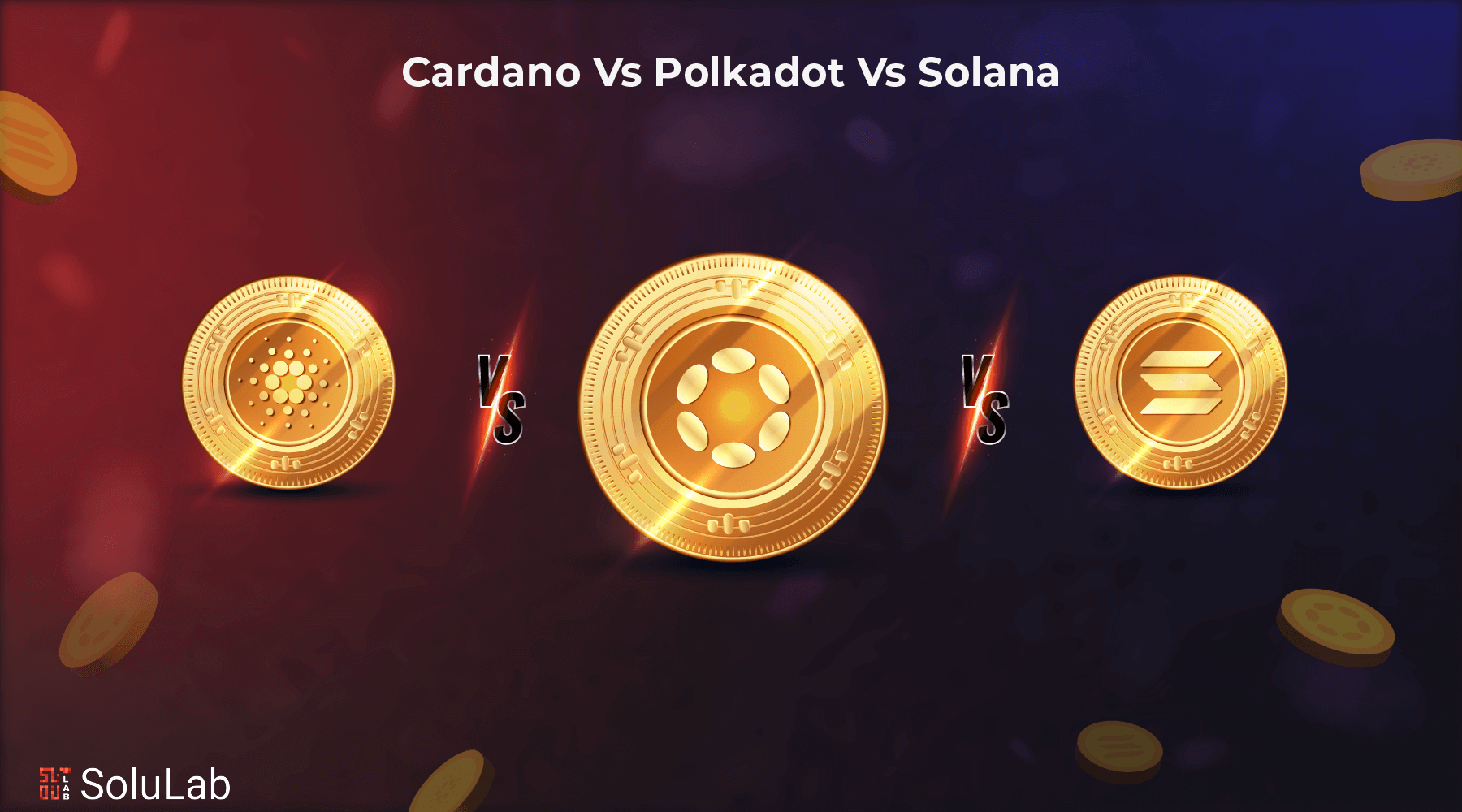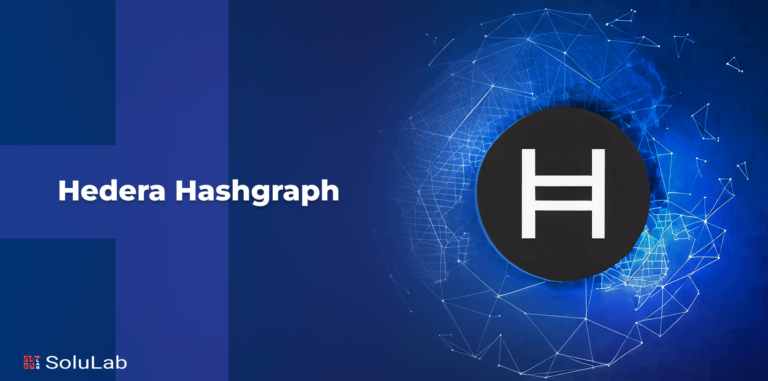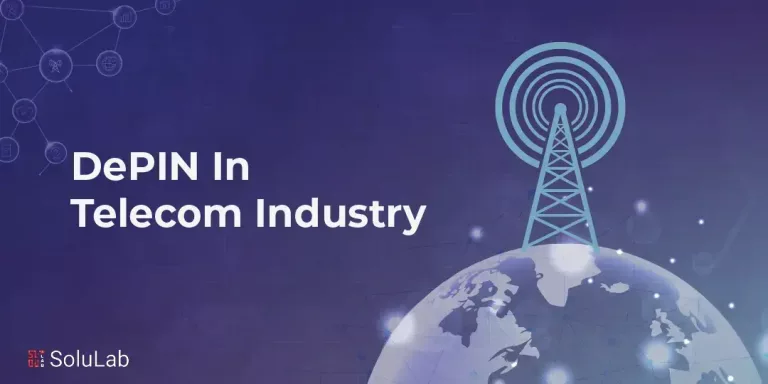
Are you having trouble deciding whether to use the Polkadot, Solana, or Cardano blockchain for your company? According to the block data, 80% out of 100 companies use blockchain technology. Many organizations embrace blockchain technology for its advantages, including increased security and confidentiality. Each blockchain, however, has unique advantages that might or might not be appropriate for a certain project.
Blockchains like Solana vs. Cardano vs. Polkadat continuously expand as chains add new blockchains, enhancing the ledger’s security. Only users of an approved system can access data on the blockchain, which is distinct because it fosters trust without requiring a reliable third party.
So, how can you pick the ideal blockchain for your company? To do so, you need to know the main distinctions between Polkadot, Solana, and Cardano, the three well-known blockchains. This detailed guide will explain each blockchain and its features.
Background of Each Blockchain
Before deciding you need to have a brief understanding of each of the blockchain platforms to make a better and more informed decision
What is Cardano?
Charles Hoskinson, a co-founder of Ethereum, developed Cardano in 2015. The Cardano blockchain is openly accessible, the system is decentralized and open-source, and consensus is established by proof of stake. According to the ruling in Solana vs Cardano vs Polkadot can utilize its token, ADA to facilitate peer-to-peer (P2P) transactions. As a third-generation platform, Cardano is an improved version as opposed to Polkadot vs Solana.
Additionally, the blockchain platform seeks to provide financial services to unbanked individuals worldwide. Additionally, one intriguing component of Cardano is the way it uses its ‘eras’ to celebrate historical individuals in computer science and poetry. The goal of the Basho scaling and optimization phase is to provide additional functionality to Cardano.
What is Polkadot?
June 2021 saw the launch of the open-source Polkadt blockchain. It makes blockchains more accessible and connected by permitting distinct chains to securely communicate and carry out transactions. It makes use of the Layer-1 blockchain known as the Kusama parachain. Over 100 para chains are supported by Kusama, and experts predict that number will continue to rise. As a component in your investment strategy, you can sell and buy DOT in addition to SOL, ADA, and DOT. Users can run customized platforms on top of a global network of personal blockchains with Polkadot, a cryptocurrecny. The Polkadot token (DOT), a cryptocurrency, serves two primary purposes inside the Polkadot blockchain network.
- With DOT, owners have the power to shape the protocol’s course.
- New DOTs are created by the Polkadot cryptocurrency network, which validates transactions by staking its money.
Blockchain numerous applications are developed by Polkadot’s para-chains and fed into the main blockchain. In comparison to ADA, SOL, and DOT, this offers para-chain interactions utilization of the same amount of security to the main chain.
What is Solana?
Solana (SOL) adds to the discussion of SOL vs ADA vs DOT. An open-source initiative called Solana creates a novel, quick, layer-1 Blockchain without permission. To boost the capacity beyond what is feasible and popular blockchain while maintaining affordable pricing, Anatoly Yakovenko created Solana in 2017.
A synchronized engine, a form of proof of state, and a transforming proof of history technique are both used in Solana’s hybrid consensus model. Therefore, without putting scaling solutions in place, Solana can handle up to 710,000 operations per second. If you create a Solana token, a third-generation blockchain framework to facilitate the development of decentralized apps and smart contracts. The project facilitates a range of Defi systems and non-fungible token exchanges. One of the most influential parties in SOL vs ADA vs Polkadot at the moment is Solana.
Benefits of Adoption of Each Blockchain
Blockchain technology provides special solutions, and a project’s particular requirement will determine which platform is the best. Let’s examine the advantages of embracing Cardano, Polkadot, and Solana:
Cardano: Ecological and Research Strictness
Cardano is disconnected by its methodical approach, which is based on a layout design and peer-reviewed research. It is one of the most environmentally sustainable blockchains due to its proof of stake, and voting process, which guarantees energy efficiency. Cardano’s emphasis on formal verification helps developers by reducing errors and vulnerabilities. It is also an excellent candidate for projects needing long-term reliability, like digital identity, management, or supply chain tracking, due to its capacity for growth through Hydra Layer 2 solutions.
Polkadot: Scalability and Interoperability
Polkadot’s distant embassies, or interoperability make it stand out its chain promotes a real web3 environment by enabling seamless communication and information sharing between numerous blockchains. Polkadot-adopting projects can create customized blockchains (parachains) that are customized for certain use cases, such as gaming or DeFi. Polkadot is perfect for cross-chain solutions and centralized applications that need to communicate between ecosystems because of its shared security paradigm, which lowers individual network liberties while preserving scalability.
Solana: Economical and Quick
Solana token services are a great option for hyper-performance apps because of their lightning-fast transaction rates and low fees. With its proof of history mechanism, it can handle more than 65,000 transactions per second, which makes it ideal for the NFT marketplace and decentralized exchanges. Due to Solana’s affordable prices, developers, and users can access it, enabling projects to grow without being constrained by fees.
Every Blockchain has its advantages. Polkadot concentrates on interoperability, Cardano emphasizes sustainability, and security, and Solana is superior in terms of speed and cost. The objectives and priorities of the project will determine which one is best.
Technological Comparison of Blockchains
| Features | Cardano | Polkadot | Solana |
| Mechanisms of Consensus | Proof of Stake | Proof of Stake nominated | Proof of Stake plus Proof of History |
| Speed of Transactions | 250 transactions per second | 1,000 transactions per second | 65,000 transactions per second |
| Scalability | Hydra Layer 2 Solution Scales | Through parachains scale | PoH enabled parallel processing scale |
| Efficiency of Energy | High (PoS included low power consumption) | High (PoS mechanism optimized) | Moderate (effective but requires more power than Cardano or Polkadot) |
| Interoperability | Restricted, sidechains will be used in plans to support cross-chain. | Robust, built with the Relay Chain in mind for multi-chain interaction. | Limited, interoperability is less important than sing-chain performance. |
| Intelligence Contracts | The Haskell-based Plutus platform prioritizes formal verification. | Uses parachains to support smart contracts. | C, C++, and Rust are supported by the Solana runtime for high-performance applications. |
| Leadership | Community vote for decentralized government. | Active involvement of stakeholders in on-chain governance. | On-chain governance is limited and depends on core developers. |
| Ecosystem of Development | Centered on methodical updates and academic rigor. | Developer-friendly with substrate architecture for blockchain development. | An environment with high performance designed for real-time applications. |
| Decentralization | High (decentralization that will happen gradually with the addition of nodes) | High decentralization is fostered by shared security. | Moderate (has comparatively fewer nodes than Polkadot and Cardano) |
Uses Cases of Each Blockchain
1. Cardano
Creating the future of multi-chain, Cardano vs Solana, Polkadot is the foundation of cross-chain solutions and web3 because of its capability and interoperability. Among the notable use cases are:
- Digital Identification Management: Initiatives, such as Atala PRISM use Cardano to offer, decentralized and safe identification solutions to both individuals and businesses. In developing nations where identification verification is difficult, this is extremely helpful.
- Defi and Smart Contracts: Cardano offers decentralized finance applications, including stablecoins, lending platforms, and these exchanges through the Plutus smart contract platform.
- Certification and Education: By enabling the organization to produce veritable certificates, Cardano’s blockchain has been utilized for credential verification, guarantee, authenticity, and blocking fraud.
- Supply Management: Cardano makes it possible to trace products, transparently, and impenetrably throughout the supply chain because its blockchain guarantees authenticity, and stakeholder trust is increased.
2. Polkadot
Creating the future of multi-chain, Polkadot is the foundation of cross-chain solutions and web3 because of its capability and interoperability. Among the notable use cases are:
- Cross-Chain DeFi: Polkadot facilitates communication between blockchain and decentralized financial systems. Parachains can be used by the project to build specialized training, staking, and lending ecosystems.
- Development of Web3: Polkadot helps decentralized apps that depend on numerous changes for functionality and data by facilitating smooth communication between them.
- NFTs and Gaming: Producing games powered by blockchain and an NFT marketplace, where high performance and connectivity are crucial, is made possible by Polkadot’s scalability and multi-chain capabilities.
- Integration of IoT: Polkadot facilitates smooth data, sharing, and automation in sectors, including agriculture, logistics, and healthcare by connecting IoT devices across several networks.
3. Solana
Energizing high-efficiency apps, Solana is well known for its quick transactions and lower fees, making it perfect for real-time application applications. Important use cases consist of:
- NFT Marketplace: Solana provides minimal cost and fast transaction velocity form and trading, powering, well-known MFT platforms, such as Metroplex and Magic Eden.
- DeFi Solutions: Decentralized exchanges, taking protocols, and lending platforms are among the decentralized finance applications that Solana supports. It is desirable for high-frequency trading due to its low latency.
- Decentralized Applications: Solana is used by developers to create a variety of dApps, such as data, storage systems, centralized social networking, networks, and payment gateways
- Metaverse and Gaming: Solana is extensively used in the virtual world and Blockchain-based gaming, where capability and performance are essential for smooth user experiences.
Strengths and Weaknesses of Each Blockchain
| Blockchain | Strength | Weakness |
| Cardano | Proof of Stake uses less energy. High security is guaranteed by rigorous verification and peer-viewed protocols. Network resilience is improved by progressively increasing the number of active nodes. | Innovation and updates may be delayed by a research-driven strategy. In contrast to rivals, dApp and ecosystem adoption is still increasing. There is still work to be done on cross-chain communication. |
| Polkadot | Relay chain makes it possible for several blockchains to communicate with each other easily. By enabling parallel processing, parachains increase transaction throughput. Substrate makes creating unique blockchains easier. | New developers may find the parachain and architecture model difficult to understand. It takes a lot of technological know-how and funding to launch parachains. |
| Solana | Developers and users may find it appealing because of its low fees. Perfect for high-performance applications like Defi, NFTs, and gaming. Capable of processing more than 65,000 transactions per second. | There may be centralization problems if there are fewer validators than rivals. Solana has seen outages and stability problems. Performance on a single-chain is prioritized over cross-chain capability. |
Investment Perspective
Cardano
It is viewed as an extended, research-driven initiative from the perspective of investment. Investors looking for stability and steady growth are drawn to its emphasis on sustainability and reviewed by experts in development. Future demand for ADA may be fuelled by Cardano’s enterprise-level adoption because of its strong security capability via Hydra. Short-term gains are at risk, nevertheless, due to its lower rate of development and less active environment than rivals. ADA is valued by investors due to its solid base and promise to address practical issues and supply chain, identity management, and DeFi.
Polkadot
Investors choose Polkadot because of its distinct capability and interoperability, which established it as a major participant in the multi-chain web three future. It is appealing for developers and projects because it encourages creativity through the creation of specific para changes. DOT is an asset that requires a lot of staking and compensates investors for their involvement. Rapid adoption might be constrained by the para-chain’s integrity and great technical entry requirements. Polkadot is a good choice for investors who are looking to the future because of its potential to dominate cross-chain solutions.
Solana
Investors looking to gain exposure to a high-performing blockchain ecosystem, find Solana appealing. It has become the preferred platform for Defi, NFTs, and gaming because of its quick transactions and inexpensive costs. The adoption of SOLN industries with significant demand is linked to its growth potential. However, risk covers investors can be turned off by worries about centralization, risk, and network disruption. SOL provides excellent shot and medium-term investment opportunities for individuals who are interested in ecosystem expansion.
The Final Word
To sum up, Cardano, Polkadot, and Solana arose from candidates in the blockchain market since they each have special advantages suited to particular use cases, Cardano’s focus on secure and sustainable platforms through research makes it appealing for long-term projects like supply chain, tracking, and digital identity management. Due to its exceptional scalability and interoperability, Polkadot is perfect for decentralized apps, cross-chain solutions, and Internet of Things integration. Meanwhile, Solana is the go-to option for advanced applications such as NFT marketplaces, DeFi, and blockchain-based games due to its speed and inexpensive transaction fees.
Your project goals, whether they are eco-friendly expansion, smooth, cross-chain, communication of blazing, or fast performance will determine which platform is best for you. Businesses and developers may ensure effective deployment and creation in the rapidly changing market by aligning their blockchain decisions with their objectives and knowing the relative benefits of each blockchain platform.
FAQs
1. Which is superior Cardano or Solana?
Solana prioritizes speed and scalability, whereas Cardnao’s Ouroboros emphasizes security. Cardano exhibits strong decentralization by running close to 2,600 validator nodes. Conversely, Solana has more than 1,300 validator nodes, requiring certain performance trade-offs with centralization.
2. Which cryptocurrency should I buy?
With a staggering 57% of the market capitalization of the whole cryptocurrency industry, Bitcoin (BTC) is the top choice for cryptocurrency investing. Additionally, Bitcoin’s value just rose by an additional 125% to surpass $100,000.
3. Is it worth investing more in Solana?
If you think Solana has the potential to continue growing its ecosystem, accelerating and obtaining more ETF approvals, it could be a wise investment. It is still an inflationary token, though, is far more difficult to value than Bitcoin.
4. Which is the better choice Cardano or Polkadot?
Polkadot wants the investors to be more involved and dedicated. The infrastructure of Cardano is double-layered, and Polkadot makes it possible to connect several blockchains to a single network. High transaction speed and cheap transaction fees are two of Cardano’s advantages.
5. Can Polkadot surpass Ethereum?
Leading para-chain-based blockchain project Polkadot (DOT) is about to make a significant advancement that would allow it to overtake rivals like Solana (SOL), Cardano (ADA), and Ethereum (ETH).





